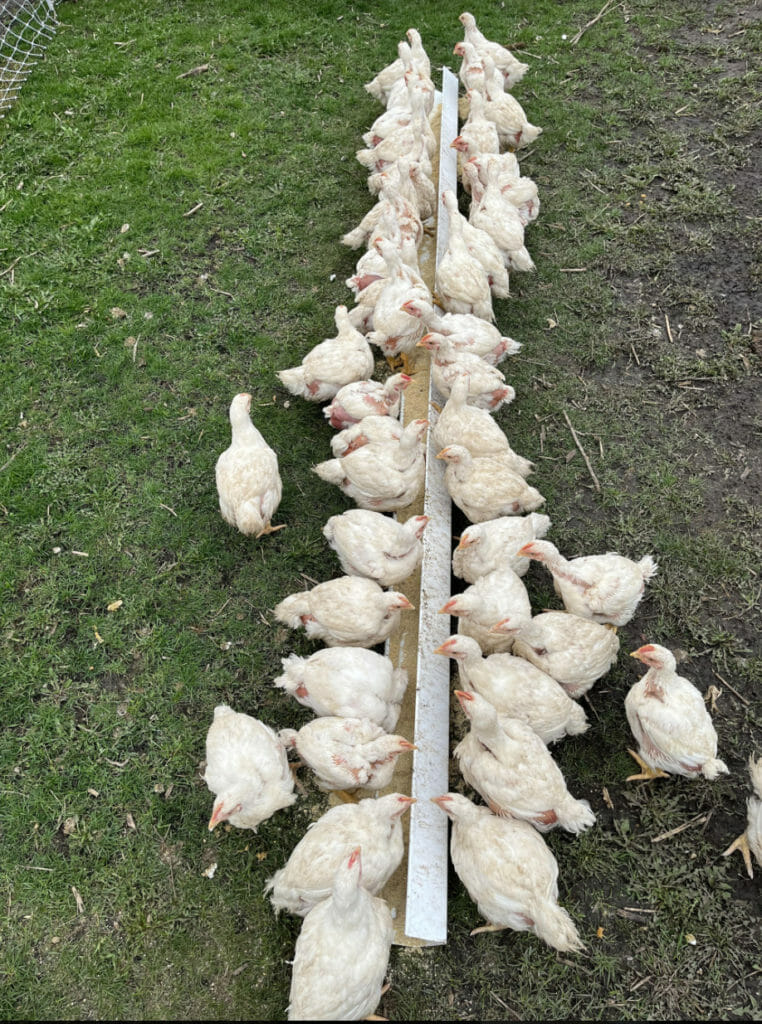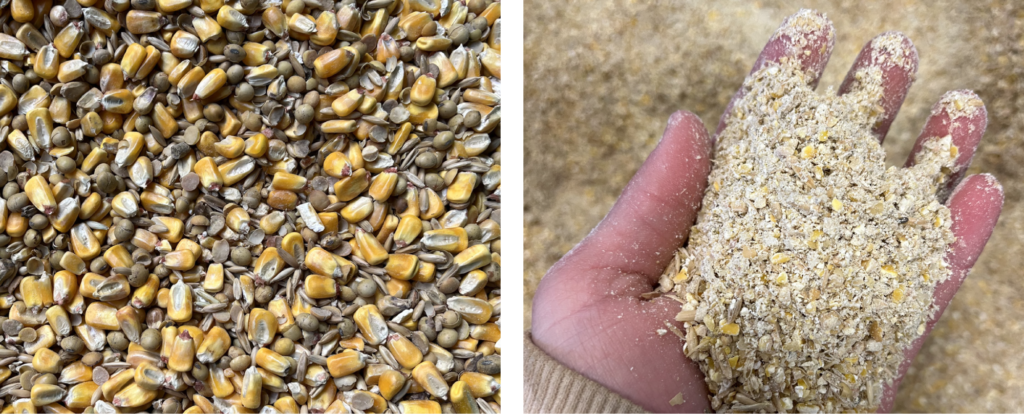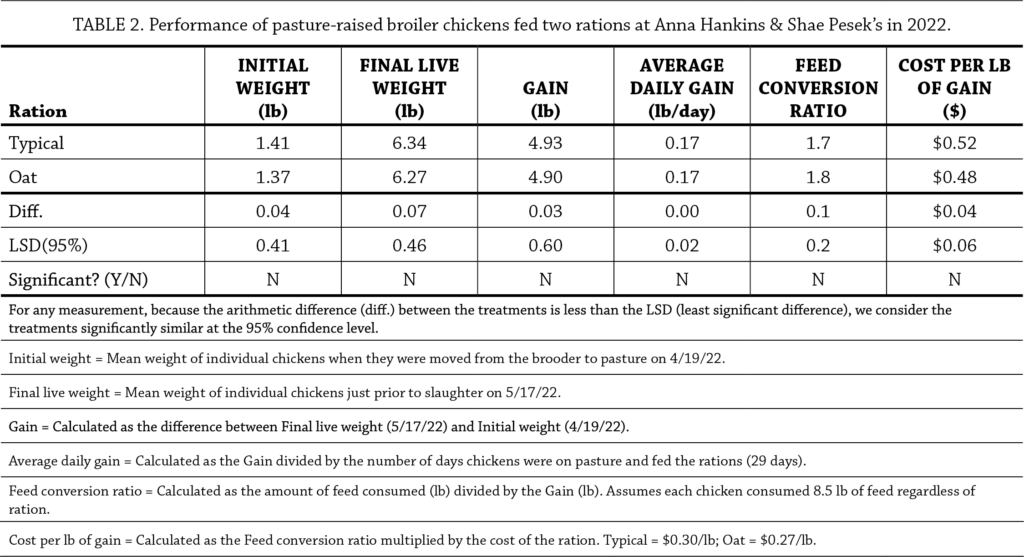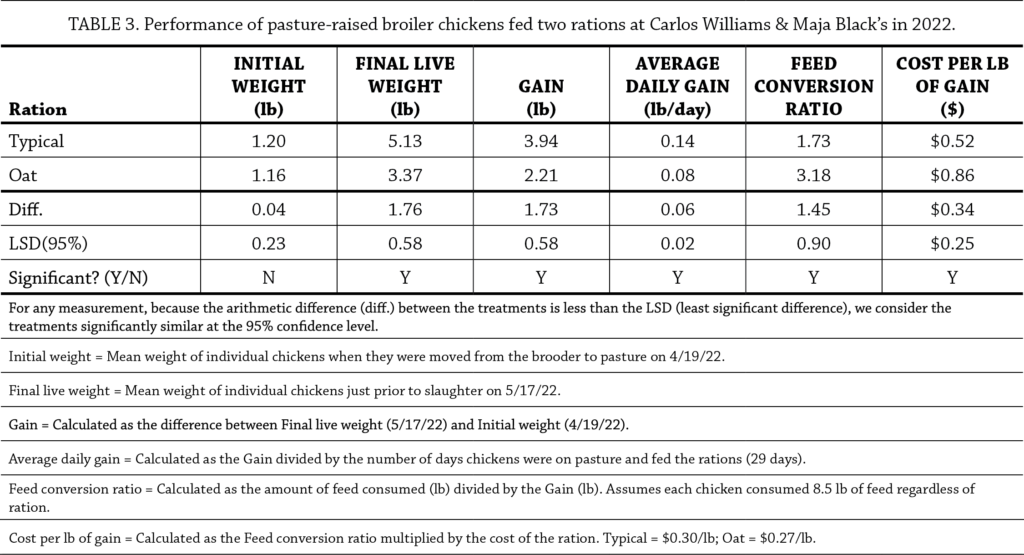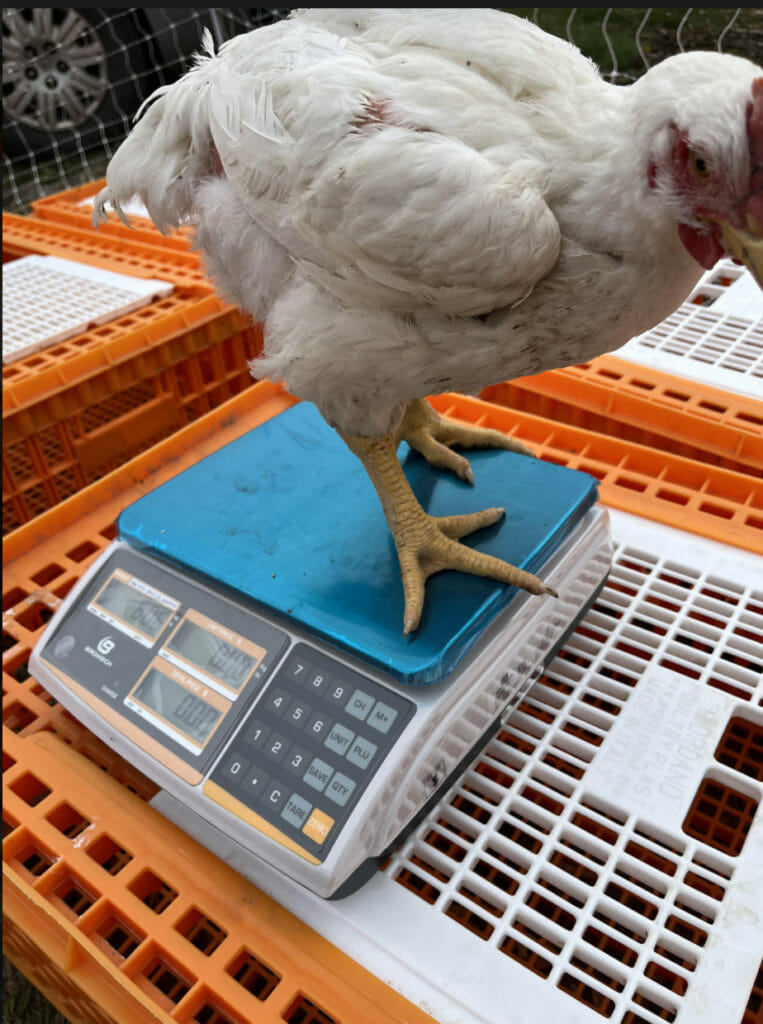Replacing Corn with Oats in Ration for Pasture-Raised Broiler Chickens
This research was funded by Walton Family Foundation.
In a Nutshell:
- Anna Hankins & Shae Pesek and Carlos Williams & Maja Black raise broiler chickens on pasture. They wondered whether replacing a portion of the corn in a typical ration with oats would affect gain and economics of the broiler chickens.
- Perhaps more importantly, the cooperators noted opportunities for marketing birds fed a diversified ration (rather than primarily corn and soybeans) as a driver for this project. Hankins said: “As direct-to-consumer farmers, there’s potential increased profitability that could come with feeding a more diverse ration due to customer desire.”
- Going into the trial, they thought the diversified ration with oats might be more expensive but that it would be compensated for by improved weight gain and vitality of the broilers. “Chicken has a very small profit margin which is why feed efficiency is so important,” Hankins said at the onset.
Key Findings
- At Hankins & Pesek’s farm, chickens fed the oat ration performed equally well as the chickens fed the typical ration in terms of gain, average daily gain, feed conversion ratio and cost per pound of gain.
- At Williams & Black’s farm, chickens fed the typical ration out-performed those fed the oat ration.
Methods
Design
To determine the effect of replacing corn with oats in the ration, Hankins & Pesek and Williams & Black compared two rations: (1) typical ration, consisting of corn, soybeans, vitamins and minerals; and (2) oat ration, in which 10% of the corn in the typical ration was replaced with oats. The typical ration was ground by and sourced from D&J Feeds (Hopkinton, IA) and cost $0.30/lb. The oat ration was ground at Sundog Farm (Solon, IA) and included a vitamin mix from Heritage Poultry VTM in order to balance the vitamins and minerals in each ration. The oat ration ended up costing less than the typical ration ($0.27/lb).
Both farms received 100 chicks in March and placed them in brooders. When it came time to move the birds to pasture, each farm divided their flocks in two: randomly assigning 50 birds to receive the typical ration and 50 birds to receive the oat ration. Both farms then selected a subset of birds to monitor from each of the two treatment groups. At Hankins & Pesek’s, chickens were raised on pasture using an “open cell system” meaning they are in electric netting with free will access to trees or shade structures but are not in tractors and do not get closed in a shelter at night. At Williams & Black’s, each treatment group was placed in separate chicken tractors on pasture. Apart from the rations, chickens were managed similarly, raised in separate enclosures on pasture and receiving equal access to feed and water. More management information for each farm is provided in Table 1. At Hankins & Pesek’s, chickens were offered the same amount of feed every day from either ration (roughly 0.3 lb feed/bird/day). At Williams & Black’s, chickens were offered 0.1 lb feed/bird/day from Apr. 19 to May 2 and were offered 0.4 lb feed/bird/day from May 3 to May 17.
Measurements
The weight of each individual chicken was recorded the day they were moved from the brooder to pasture. To determine the average final live weight, each individual chicken was weighed just before slaughtering, plucking and dressing. This occurred on May 17 at both farms.
Data analysis
To evaluate the effect of ration on final live weight, average daily gain, feed conversion ratio and cost per pound of gain for chickens, we calculated the least significant difference (LSD) using a t-test. If the difference between the average weights of the two treatment groups was greater than or equal to the LSD, we considered this a statistically significant effect. On the other hand, if the difference resulting between the two groups was less than the LSD, we considered the groups to be statistically similar. We used a 95% confidence level to calculate the LSDs, which means that we would expect our findings to occur 95 times out of 100.
Results and Discussion
Hankins & Pesek
Final live weight, gain, average daily gain and feed conversion ratio were statistically similar between treatment groups at Hankins & Pesek’s farm (Table 2). In other words, the chickens fed the oat ration performed equally well as the chickens fed the typical ration. There was a slight numeric economic advantage to the oat ration because it was less expensive than the typical ration and chickens performed similarly on either ration. This economic advantage (cost per lb of gain) was not statistically significant, though. Hankins was pleased with the results and said, “I feel like the corn-soybean ration for broilers is well documented and very successful and advantages for diversified diets may not be as apparent statistically but are something to consider for consumer demand and market differentiation of our birds.”
Williams & Black
Unlike at Hankins & Pesek’s, the typical ration resulted in statistically greater final live weight, gain, average daily gain, feed conversion ratio and cost per pound of gain at Williams & Black’s farm (Table 3). Gain and average daily gain from the oat ration were roughly half those from the typical ration. As a side observation, Williams noted chickens fed the typical ration were very feed focused whereas chickens fed the oat ration were a lot more inclined to forage and diversify their diet on pasture.
Conclusions and Next Steps
The cooperators went into the trial thinking the oat ration would be more expensive than the typical ration but that broilers fed the oat ration would perform better. For Hankins and Pesek, it turned out that the oat ration cost less than the typical ration and that broilers fed either ration performed similarly. “I’m so excited about this trial because it means we’ve done so much poultry math this spring and we are so much more in the know about our own cost analysis when it comes to feed and we have improved our production tremendously by making more observations about access to feed and why increasing our efficiency is so important,” Hankins said of their trial. She also remarked that the very act of monitoring broiler gain on pasture was valuable to their operation. “In a pasture setting there are many factors out of our control but this trial made us think about the factors that are in our control and how we best keep them consistent.” Black found it interesting that they saw different results from Hankins & Pesek’s farm and the trial also helped her realize the most appropriate strategy going forward: “Even if there had been a difference in rate of gain or cost [between the rations], we currently do not have the infrastructure to continue grinding our own rations, making the typical ration still a more affordable and convenient choice.”


